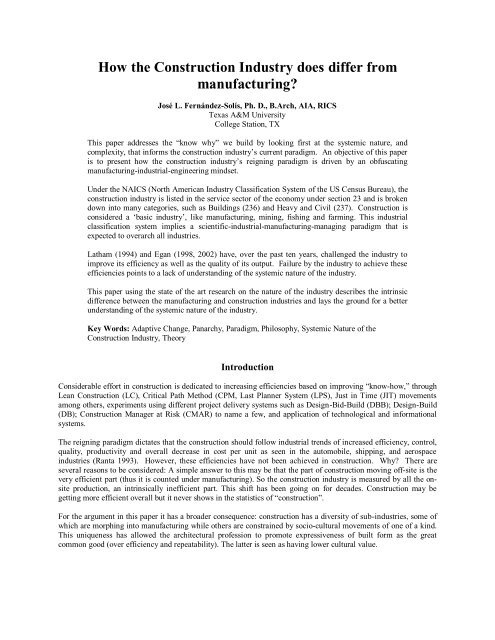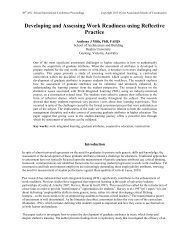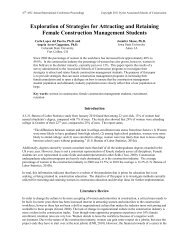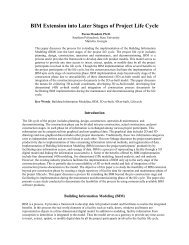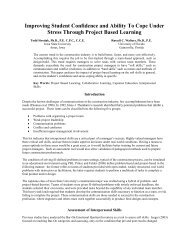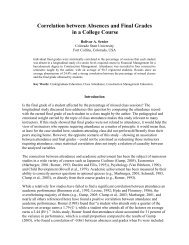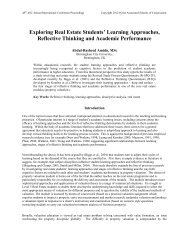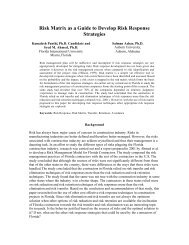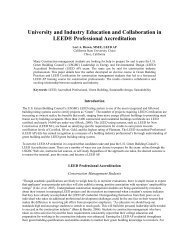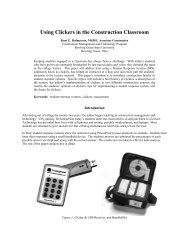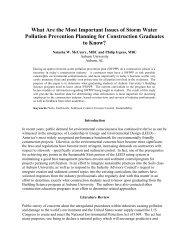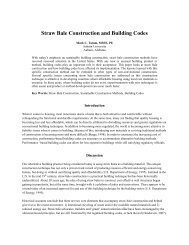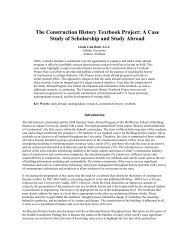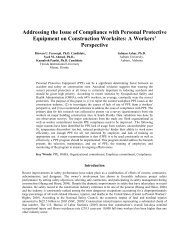How the Construction Industry does differ from manufacturing?
How the Construction Industry does differ from manufacturing?
How the Construction Industry does differ from manufacturing?
- No tags were found...
You also want an ePaper? Increase the reach of your titles
YUMPU automatically turns print PDFs into web optimized ePapers that Google loves.
<strong>How</strong> <strong>the</strong> <strong>Construction</strong> <strong>Industry</strong> <strong>does</strong> <strong>differ</strong> <strong>from</strong><strong>manufacturing</strong>?José L. Fernández-Solís, Ph. D., B.Arch, AIA, RICSTexas A&M UniversityCollege Station, TXThis paper addresses <strong>the</strong> “know why” we build by looking first at <strong>the</strong> systemic nature, andcomplexity, that informs <strong>the</strong> construction industry‟s current paradigm. An objective of this paperis to present how <strong>the</strong> construction industry‟s reigning paradigm is driven by an obfuscating<strong>manufacturing</strong>-industrial-engineering mindset.Under <strong>the</strong> NAICS (North American <strong>Industry</strong> Classification System of <strong>the</strong> US Census Bureau), <strong>the</strong>construction industry is listed in <strong>the</strong> service sector of <strong>the</strong> economy under section 23 and is brokendown into many categories, such as Buildings (236) and Heavy and Civil (237). <strong>Construction</strong> isconsidered a „basic industry‟, like <strong>manufacturing</strong>, mining, fishing and farming. This industrialclassification system implies a scientific-industrial-<strong>manufacturing</strong>-managing paradigm that isexpected to overarch all industries.Latham (1994) and Egan (1998, 2002) have, over <strong>the</strong> past ten years, challenged <strong>the</strong> industry toimprove its efficiency as well as <strong>the</strong> quality of its output. Failure by <strong>the</strong> industry to achieve <strong>the</strong>seefficiencies points to a lack of understanding of <strong>the</strong> systemic nature of <strong>the</strong> industry.This paper using <strong>the</strong> state of <strong>the</strong> art research on <strong>the</strong> nature of <strong>the</strong> industry describes <strong>the</strong> intrinsic<strong>differ</strong>ence between <strong>the</strong> <strong>manufacturing</strong> and construction industries and lays <strong>the</strong> ground for a betterunderstanding of <strong>the</strong> systemic nature of <strong>the</strong> industry.Key Words: Adaptive Change, Panarchy, Paradigm, Philosophy, Systemic Nature of <strong>the</strong><strong>Construction</strong> <strong>Industry</strong>, TheoryIntroductionConsiderable effort in construction is dedicated to increasing efficiencies based on improving “know-how,” throughLean <strong>Construction</strong> (LC), Critical Path Method (CPM, Last Planner System (LPS), Just in Time (JIT) movementsamong o<strong>the</strong>rs, experiments using <strong>differ</strong>ent project delivery systems such as Design-Bid-Build (DBB); Design-Build(DB); <strong>Construction</strong> Manager at Risk (CMAR) to name a few, and application of technological and informationalsystems.The reigning paradigm dictates that <strong>the</strong> construction should follow industrial trends of increased efficiency, control,quality, productivity and overall decrease in cost per unit as seen in <strong>the</strong> automobile, shipping, and aerospaceindustries (Ranta 1993). <strong>How</strong>ever, <strong>the</strong>se efficiencies have not been achieved in construction. Why? There areseveral reasons to be considered: A simple answer to this may be that <strong>the</strong> part of construction moving off-site is <strong>the</strong>very efficient part (thus it is counted under <strong>manufacturing</strong>). So <strong>the</strong> construction industry is measured by all <strong>the</strong> onsiteproduction, an intrinsically inefficient part. This shift has been going on for decades. <strong>Construction</strong> may begetting more efficient overall but it never shows in <strong>the</strong> statistics of “construction”.For <strong>the</strong> argument in this paper it has a broader consequence: construction has a diversity of sub-industries, some ofwhich are morphing into <strong>manufacturing</strong> while o<strong>the</strong>rs are constrained by socio-cultural movements of one of a kind.This uniqueness has allowed <strong>the</strong> architectural profession to promote expressiveness of built form as <strong>the</strong> greatcommon good (over efficiency and repeatability). The latter is seen as having lower cultural value.
Models <strong>from</strong> O<strong>the</strong>r IndustriesThe models of <strong>the</strong> aircraft, shipbuilding, automobile and o<strong>the</strong>r industries should have been sufficient to manageconstruction complexity if building construction has <strong>the</strong> characteristic of <strong>the</strong>se mass production industries. <strong>How</strong>everif building construction <strong>does</strong> not reflect <strong>the</strong> characteristics of <strong>the</strong>se industries, <strong>the</strong>n a new model is needed.For example, let us compare <strong>the</strong> aircraft industry with construction instead of <strong>the</strong> o<strong>the</strong>r way around. In this case,each artifact (airplane) would be constructed for one client with <strong>differ</strong>ing requirements than any o<strong>the</strong>r, for one typeof specific use (say one route). Although <strong>the</strong> plane could be constructed out of an existing catalogue of parts, itwould be designed and built by a team that came into being just for this purpose. Fur<strong>the</strong>rmore <strong>the</strong> airplane wouldhave to be built or assembled on a site open to <strong>the</strong> elements. The artifact would be unique, meeting governingrequirements and obeying <strong>the</strong> laws of nature, but a distinct product. Academicians and some practitioners in <strong>the</strong>construction industry believe that <strong>the</strong>ories and practices <strong>from</strong> one are translatable to <strong>the</strong> o<strong>the</strong>r. What prevent<strong>the</strong>oretical translation are <strong>differ</strong>ences in scale and <strong>differ</strong>ences in emphasis between product and processes.Sam Grawe, (editor in chief of Dwell, a San Francisco-based magazine) compares construction with <strong>the</strong> automotiveindustry: “The reality of <strong>the</strong> situation is that for decades architects and even some builders have been aware of <strong>the</strong>inefficiencies of site-built, stick –built homes. The common analogy is whe<strong>the</strong>r you would feel comfortable hiring arandom contractor to come and build your car in your driveway, leaving it exposed to <strong>the</strong> elements every night afterhe toes home and ordering every part piece by piece.” (FT 7/13/08).<strong>Construction</strong> in general <strong>does</strong> not behave as an “industry,” but more like a “conglomerate of industries,” an “industryof industries,” a “meta-industry.” The meta-industry metaphor is used borrowing Palmer‟s (2003, 2004) concept ofmeta-system which by definition includes holes, absurdities, inefficiencies, and paradoxes as well as <strong>the</strong> capacity toinvent and innovate. If this is <strong>the</strong> case, past behavior of specific industries is not directly translatable to <strong>the</strong> behaviorof a meta-industry, mainly because <strong>the</strong> subtle but real <strong>differ</strong>ence in scale and domains. This line of generic andstructural thinking regarding complexity and <strong>the</strong> systemic nature of building construction as a meta-industry requiresadditional foundational work. We may look, in future work, at Gunderson and Holling (2002), Panarchy and <strong>the</strong><strong>the</strong>ories of adaptive change as a better fit for construction.Towards an Understanding of <strong>the</strong> Systemic Nature of <strong>the</strong> <strong>Industry</strong>Koen (1985, 2003) succinctly states that <strong>the</strong> engineering method under which building construction can be located isbased on “change,” utilizing available resources, and is based on some “particular rationality” (albeit heuristic ra<strong>the</strong>rthan scientific in his view). This rationality is derived <strong>from</strong> “<strong>the</strong> state of <strong>the</strong> art” at that point in time, directedtowards a “best or optimum solution,” but always occurring in an “environment of uncertainty.” All types ofengineering, science, and philosophy fall under <strong>the</strong> category of heuristics, according to Koen (2003). Koen proposes<strong>the</strong> following example of heuristic rationality:“…[A]t <strong>the</strong> appropriate point in a project, freeze <strong>the</strong> design; allocate resources as long as <strong>the</strong> cost ofnot knowing exceeds <strong>the</strong> cost of finding out; allocate sufficient resources to <strong>the</strong> weak link; and solveproblems by successive approximation.”In a construction project, uncertainties (Bertelsen 2005, 2004, 2003; Bertelsen and Emmitt 2005) are due totemporary coalitions in a turbulent environment requiring semi-predictable or even unpredictableconfigurations of supply industries and technical skills. Groák (1992, 1994), and Polanyi (1967, 1974), call<strong>the</strong>se “technological paradigms” organized around a “project” and not <strong>the</strong> “firm or production process”(Nightingale 2000) a major paradoxical distinction between construction and <strong>manufacturing</strong>. Paradoxicallyalthough <strong>the</strong> axis of a project is essential, <strong>the</strong> defining characteristic of <strong>the</strong> systemic nature of buildingconstruction is a “dynamic process.”A clear distinction between construction and <strong>the</strong> traditional definition of an industry, like <strong>manufacturing</strong>, isessential for an understanding of <strong>the</strong> systemic nature of <strong>the</strong> “industry.” The capacity of <strong>the</strong> industry(Hillebrandt, 1975, Pearce 2006) or potential is revealed in <strong>the</strong> use of <strong>differ</strong>ent distinct resources and skillbases for <strong>differ</strong>ent building types and <strong>differ</strong>ent construction sectors (civil, building, industrial, <strong>manufacturing</strong>,
housing, and medical). These construction sectors are in fact <strong>differ</strong>ent “industries,” according to Kodama(1992): “We are moving away <strong>from</strong> <strong>the</strong> idea of „one technology, one industry‟ as <strong>the</strong> framework of analysisfor building construction capacity for change.” Fur<strong>the</strong>rmore, not only are we moving away <strong>from</strong> anunderstanding of construction as encompassing only one industry, but of several industries (Kodama 1992),and altoge<strong>the</strong>r <strong>from</strong> <strong>the</strong> model of an “industry” as understood in <strong>manufacturing</strong> and defined by “industrialscience” <strong>the</strong>ories and practices. Is this a semantic or a real distinction?Groák (1992, 1994) states “we should no longer treat construction activities as belonging to „an industry‟ withdefinable boundaries, specific technical skills and using specific resources.” The focus is continually shiftingmore and more towards its end-products and services, recognizing increasing external linkages and potentialinnovations <strong>from</strong> beyond “construction” where <strong>the</strong> construction capacity resides according to Hillebrandt(1974, 1975, 1984), a position embraced by Pearce (2003, 2006) and followers.Metaphysical basis for Distinctions between Product and ProcessesKoskela and Kagioglou‟s (2006) research states that since <strong>the</strong> pre-Socratic period, <strong>the</strong>re have been two basicmetaphysical worldviews. The thing-oriented view seems to lead to analytical decomposition, <strong>the</strong> requirement orassumption of certainty and a more static philosophical approach. They argue that “production” is intrinsically aprocess-oriented endeavor. <strong>How</strong>ever, an analysis of current conceptualizations shows that it is <strong>the</strong> thing-orientedview of <strong>the</strong> world (product) that has dominated research and practice of production management (Nightingale 2000).What <strong>the</strong> authors mean by this is that research and production management practices have used <strong>the</strong> Cartesianmethod of problem decomposition (Descartes‟ (1898) second rule; Cottingham 1986). Thus, according to Koskelaand Kagioglou (2006), <strong>the</strong> general direction of research (and production management) is achieved by going intoeven smaller parts of <strong>the</strong> whole and searching for explanations at <strong>the</strong> lowest possible reductionist level, as used byNewton and followers, also known as <strong>the</strong> scientific approach.The two underlying assumptions behind <strong>the</strong> thing-oriented worldview as related to decomposition are: (i) similarityand (ii) independence of decomposed elements or parts. Koskela and Kagioglou (2006) state: “<strong>the</strong> similarityassumption takes it for granted that <strong>the</strong> parts are, by nature, similar to <strong>the</strong> whole and thus also mutually similar. Theassumption of <strong>the</strong> independence of parts follows <strong>from</strong> <strong>the</strong> similarity assumptions. Namely, if our unit of analysis isan idea, problem or thing in itself, so will all decomposed parts also be ideas, problems or things in <strong>the</strong>mselves.”On <strong>the</strong> o<strong>the</strong>r hand, process metaphysics holds that “everything flows” and is in “change” (Weick 2000). Accordingto Rescher (2000), a contemporary understanding of process metaphysics, as quoted by Koskela and Kagioglou(2006), follows:Time and change are among <strong>the</strong> principal categories of metaphysical understanding;Processes are more fundamental than things (i.e. projects) for <strong>the</strong> purposes of ontological <strong>the</strong>ory;Contingency, emergence, novelty and creativity are fundamental categories of (process) metaphysics.Rescher (2000) defines process as a structured sequence of successive stages or phases, having three characteristics(thus establishing <strong>the</strong> criteria for processes):A process and a product are duals of each o<strong>the</strong>rA process and a product have a relativistic space-time and time-space relation to each o<strong>the</strong>r found inrelativity <strong>the</strong>ory.There is a process phase and a product phase of <strong>the</strong> phase space of <strong>the</strong> entity.Processes and products vary along a spectrum <strong>from</strong> simple to complex.Both processes and products can have parts, but <strong>the</strong> parts of processes are staged in time.Processes take place in relation to a reference while products appear in <strong>the</strong> background of o<strong>the</strong>rprocesses.Thus perceptually, processes and products are based on flow and gestalt. Flows can be seen as temporalgestalts, where it takes time for <strong>the</strong> figure to appear on <strong>the</strong> background, while spatially simultaneous to<strong>the</strong> appearance of products on <strong>the</strong>ir ground.Unity and totality and wholeness of processes and products are not intrinsic but something which appearsas we look at <strong>the</strong> mereology (whole part relations within <strong>the</strong> process and product).
At <strong>the</strong> pattern level <strong>the</strong>re are structures and flows as well as signs and values.At <strong>the</strong> form level <strong>the</strong>re is <strong>the</strong> shape and behavior of an object as well as states and events (such asreceiving messages)<strong>Construction</strong>, to build, as a verb, an activity, is about “change.” To have a building is to have first <strong>the</strong> activity thatcreated <strong>the</strong> building as understood by Aristotle. Imai‟s (1986) Kaizen observes that <strong>the</strong>re are two types of changes:abrupt change such as <strong>the</strong> <strong>differ</strong>ence between two sets of things (i.e. <strong>the</strong> natural and <strong>the</strong> artificial environments) andchange as <strong>the</strong> process between <strong>the</strong> now and <strong>the</strong> after now.Changes occur at a macro level (industry, economy, society) and micro level (<strong>the</strong> firm, project specific organizationand <strong>the</strong> project itself). The essence of this activity is environmental change: where <strong>the</strong>re was nothing, now <strong>the</strong>re is abuilding, through <strong>the</strong> process of construction. Because <strong>the</strong> arena of change is <strong>the</strong> natural environment interactingwith an artificial environment, it can be argued that building construction, as well as construction in general, is aprocess, but with a project‟s outcome (product) as its essential secondary axis. As a process, it is always “now this,<strong>the</strong>n that”; it is complex as we have noted, with a temporal and in-eliminable spatial-temporal dimension;fur<strong>the</strong>rmore, <strong>the</strong> building construction process has its own structure.In contrast, <strong>manufacturing</strong> is a product but with a process as its essential secondary axis (see Figure 1). This is like<strong>the</strong> <strong>differ</strong>ence between <strong>the</strong> space-time and <strong>the</strong> time-space matrix. Manufacturing operates in space-time andconstruction in time-space (see Heidegger‟s 1962).Mass product <strong>manufacturing</strong> is a tightly coupled system (with product in its main axis and process as <strong>the</strong> enablingcharacteristic), whereas building construction is a loosely coupled system (Dubois and Gadde, 2002), a process as itsmain axis and product, which highlights <strong>the</strong> <strong>differ</strong>ence in <strong>the</strong> two systems (Nightingale 2000). Mass product<strong>manufacturing</strong>, as a tightly coupled industrial system, exhibits <strong>the</strong> following characteristics:Delays are not allowed or possibleSequence of events are invariant (except in flexible <strong>manufacturing</strong> schemes)Alternative paths are tightly controlled or not availableLittle or no opportunity for substitution or repair (usually discarded, wasted)Slack is not desirableRedundancies are designed and deliberateIn contrast, building construction, as a loosely coupled system, exhibits <strong>the</strong> following characteristics (Dubois andGadde 2002; Nam and Tatum 1988):Number of permutations and possible combinations are enormous (Weick 1994, 2000)Complex operations (Gidado 1996; Baccarini 1996)Inefficient operations (Cox and Townsend 1998)Sub-optimization (Gann 1996)Some tightly coupled, some time sensitive specialized activities with sequentially interdependentactivities with standard parts (Gidado 1996)Mostly, it is a loosely coupled system (Dubois and Gadde 2002)Overlapping activities; long lead time and slack built inAdaptive on-site changes (Vrijhoef and Koskela 2005) and consequential changes (Crichton 1966)Generation of variations (Akintoye et al 2000)Self-determination; coordination with <strong>differ</strong>ent firms, each adding a measure of slackWork is redone when non-conforming, ra<strong>the</strong>r than product discarded as in <strong>manufacturing</strong>It is reasonable to infer that building construction as a process is bounded at <strong>the</strong> upper end of <strong>the</strong> taxonomy bysystems (and even meta-systems) with complex process driven entities. <strong>How</strong>ever, at <strong>the</strong> same time, <strong>the</strong>boundaries at <strong>the</strong> lower end are assemblies that are product driven entities (see Figure 2). Perhaps this duality ofprocess and product underlies <strong>the</strong> thinking of <strong>the</strong> proponents that want to make building construction more like<strong>manufacturing</strong>--product driven.
Building construction‟s capacity for change, potential, is <strong>the</strong>refore an intrinsic source as well as a recipient ofvariability, inefficiency, non-linearity, and comfort with chaos, creativity, novelty, uniqueness and even paradoxand ambiguity, i.e. all <strong>the</strong> problems associated with embodiment. A high capacity for change implies freedom atmany levels of <strong>the</strong> Panarchy. In o<strong>the</strong>r words, <strong>the</strong> meta-systems nesting allow a high degree of inventiveness,promotes creativity, and celebrates diversity, adaptive change.The capacity for change is fur<strong>the</strong>rmore exacerbated at <strong>the</strong> product end and <strong>the</strong> client himself is a complex systemand source of variability (Cherns and Bryant 1984; Pries et al. 2004). This “product” axis of <strong>the</strong> paradox alsoexhibits <strong>the</strong> characteristics of: uniqueness, expression, one-of-a-kind, on a particular site with particularcharacteristics, actors selected and acting autonomously (Koskela 2000).It is <strong>the</strong>n prudent to say that <strong>from</strong> both <strong>the</strong> supply and <strong>the</strong> demand side, <strong>from</strong> <strong>the</strong> process and <strong>the</strong> product, and as amatter of fact <strong>from</strong> <strong>the</strong> milieu where building construction takes place, <strong>the</strong> fundamental characteristics ofbuilding construction are those of a complex system, process driven with a normative capacity for change.ConclusionsWe have analyzed past and current studies as a point of departure for an inquiry into <strong>the</strong> nature of systems that couldhelp identify <strong>the</strong> necessary and sufficient characteristics that allows us to glimpse <strong>the</strong> systemic nature of <strong>the</strong>construction industry.<strong>Construction</strong>‟s reigning paradigm of being an “industry” <strong>does</strong> not quite capture <strong>the</strong> complexities embedded in <strong>the</strong>process of creating infrastructure and/or a building. The dynamics of construction go beyond systems dynamics dueto <strong>the</strong> nature of its complexities. The application of current efforts to improve efficiency and effectiveness continueto generate significant <strong>differ</strong>ences between expectations and results. These <strong>differ</strong>ences point to anomalies between<strong>the</strong> current paradigm and its reality.Manufacturing and <strong>Construction</strong> are two <strong>differ</strong>ent entities although <strong>the</strong>re are manufactured products in constructionand some of <strong>the</strong> processes such as those found in <strong>the</strong> airline and automobile industry are translatable to constructionas in <strong>the</strong> Lean <strong>Construction</strong> Project Delivery System approach. <strong>How</strong>ever <strong>the</strong> essence of <strong>the</strong> nature of <strong>the</strong>construction industry as a meta-industry permeates its processes and products rendering a direct comparison ofconstruction with <strong>the</strong> systemic nature of <strong>manufacturing</strong> not realistic.ReferencesAkintoye, A., McIntosh, G. and Fitzgerald, E., 2000, A survey of supply chain collaboration and management in <strong>the</strong>UK construction industry, European Journal of Purchasing and Supply Management, (6)159-69Baccarini, D., 1996, The Concept of Project Complexity – a Review, International Journal of Project Management,14(4) pp 201-204.Ballard, G., <strong>How</strong>ell, G., 2003, Comparing <strong>Construction</strong> Management Paradigms, ASCE <strong>Construction</strong> ResearchCongress, Honolulu, Hawaii, March 19-21, 2003, 8p.Bertelsen, S., 2005, Modularization – a new approach in making construction lean? Proceedings 13th Annualconference in <strong>the</strong> International Group for Lean <strong>Construction</strong> (IGLC), Sydney, AustraliaBertelsen, S., 2004, <strong>Construction</strong> Management in a Complexity Perspective, Proceedings 1st International SCRISymposium, University of Salford, UKBertelsen, S., 2003, <strong>Construction</strong> as a Complex System, IGLC-11, Blacksburg, Virginia, pp 11-23.
Bertelsen, S., Emmitt, S., 2005, The client as a complex and chaotic system, Proceedings 13th Annual conference in<strong>the</strong> IGLC, Sydney, AustraliaCherns, A., B., Bryant, D., T., 1984, Studying <strong>the</strong> Client’s Role in <strong>Construction</strong> Management, (2)177-184.Cottingham, J., (Trans.), 1986, Rene Descartes in his Meditations on First Philosophy – With selections <strong>from</strong> <strong>the</strong>Objections and Replies Cambridge University Press, NY, 120pCox, A., Townsend, M., 1998, Strategic Procurement in <strong>Construction</strong>, Towards Better Practice in <strong>the</strong> Managementof <strong>Construction</strong> Supply Chains, Thomas Telford, London.Crichton, C., 1996, Interdependence and Uncertainty: A study of <strong>the</strong> building industry, Tavistock, London.Descartes, R., 1898, Discourse on Method and <strong>the</strong> Meditations, Translated by John Veitch. Prome<strong>the</strong>us Books.Dubois, A., Gadde, L-E., 2002, The <strong>Construction</strong> <strong>Industry</strong> as a Loosely Coupled System: Implications forProductivity and Innovation, <strong>Construction</strong> Management and Economics, 20 (7)621-631.Egan, J., 1998, Rethinking <strong>Construction</strong>: The Report of <strong>the</strong> <strong>Construction</strong> Task Force, Department of <strong>the</strong>Environment, Transport and <strong>the</strong> Regions, London.Egan, J., 2002, Accelerating Change, <strong>Construction</strong> <strong>Industry</strong> Council, available at:http://www.strategicforum.org.uk/, accessed 25 May 2006Eriksson, L. J., 1997, <strong>How</strong> Technology Evolves, Complexity, John Wiley & Sons 2(3)23-30.Gann, D.M., 1996, <strong>Construction</strong> as a <strong>manufacturing</strong> process? Similarities and <strong>differ</strong>ences between industrializedhousing and car production in Japan, <strong>Construction</strong> Management and Economics, 14(5)437-450Gidado, K. I., 1996, Project complexity: <strong>the</strong> focal point of construction production planning, <strong>Construction</strong>Management and Economics, (14)213-25Groák, S., 1992, The Idea of Building, E & FN Spon, London.Groák, S., 1994, Is <strong>Construction</strong> an <strong>Industry</strong>? Notes Towards a Greater Analytical Emphasis on External Linkages,<strong>Construction</strong> Management and Economics, 12 (4)287-293.Gunderson, L. H., and Holling, C. S., 2002, Panarchy – Understanding Transformations in Human and NaturalSystems, Island Press, Washington, DC, 507p.Heidegger, M., 1962, Being and Time, New York: Harper & Row.Hillebrandt, P. M., 1974, Economic Theory and <strong>the</strong> <strong>Construction</strong> <strong>Industry</strong>, McMillan, London.Hillebrandt, P. M., 1975, The capacity of <strong>the</strong> industry, In Aspects of <strong>the</strong> Economics of <strong>Construction</strong>, Turin, D. A.,(ed.), George Godwin, London, 225-57.Hillebrandt, P. M., 1984, Analysis of <strong>the</strong> British <strong>Construction</strong> <strong>Industry</strong>, McMillan, London.Imai, M., 1986, Kaizen, <strong>the</strong> key to Japan’s competitive success, Random House, NY, 259p.Kodama, F., 1992, Technology fusion and <strong>the</strong> new R + D, Harvard Business Review, July-August, 70-8.Koen, B., V., 2003, Discussion of THE Method: Conducting <strong>the</strong> Engineer’s Approach to Problem Solving, OxfordUniversity Press, New York, 260p.
Koskela, L., 2000, An exploration towards a production <strong>the</strong>ory and its application to construction, VTTPublications 408, VTT, Espoo, Building Technology, 296pKoskela, L. and Kagioglou, M., 2006, On <strong>the</strong> Metaphysics of Production, International Group of Lean <strong>Construction</strong>(IGLC), 13.Koskela L., Vrijhoef, R., 2001, Is <strong>the</strong> current <strong>the</strong>ory of construction a hindrance to innovation? Building Researchand Information, 29(3)197-207Kuhn, T., 1962, The Structure of Scientific Revolutions, The University of Chicago Press, Chicago, 172p.Kuhn, T., 2000, The Road Since Structure, Ed by James Conant and John Haugeland, The University of ChicagoPress.Latham, M., 1994, Constructing <strong>the</strong> team: The final report of <strong>the</strong> Government/<strong>Industry</strong> Review of Procurement andContractual Arrangements in <strong>the</strong> UK <strong>Construction</strong> <strong>Industry</strong>, HMSO, LondonNAICS North American <strong>Industry</strong> Classification System, http://www.census.gov/epcd/naics02/naicod02.htm, dateaccessed 28 October 2008Nam, C., H., Tatum, C., B., 1988, Major Characteristics of Constructed Products and Resulting Limitations of<strong>Construction</strong> Technology, <strong>Construction</strong> Management and Economics, 6,133-148.Nightingale, P., 2000, The Product-process-organization Relationship in Complex Development Projects, ResearchPolicy, 29, 913-930.Palmer, K. D., 2003, General Schemas Theory See http://archonic.net, date accessed 20 Sept. 2005Palmer, K.D., 2004, Nondual Science, see http://nondual-science.net, date accessed 20 Sept. 2005Pearce, D. W., 2003, The Social and Economic Value of <strong>Construction</strong>: The <strong>Construction</strong> <strong>Industry</strong>‟s Contribution toSustainable Development [Pearce Report], New <strong>Construction</strong> Research and Innovation Strategy Panel (nCRISP),London (available at: http://www.ncrisp.org.uk) accessed 24 May 2006.Pearce, D. w., 2006, Is <strong>the</strong> construction industry sustainable? Definitions and reflections, Building Research &Information, Taylor & Francis 34(3) 201-207.Polanyi, M., I., 1967, “The Tacit Dimension,” New York: Anchor BooksPolanyi, M., 1974, Personal Knowledge: Towards a Post-Critical Philosophy, Chicago, The University of ChicagoPress.Pries, F., Doree, A., Van der Veen, B., Vrijhoef, R., 2004, The Role of Leader‟s Paradigm in <strong>Construction</strong> <strong>Industry</strong>Change, <strong>Construction</strong> Management and Economics 22, 7-10.Ranta, J., 1993, On <strong>the</strong> Dynamics and Evolution of Production Paradigms, SITRA 130, Helsinki.Rescher, N., 2000, Process Philosophy, University of Pittsburgh Press, Pittsburgh, 144pVrijhoef, R., Koskela, L., 2005, Revisiting <strong>the</strong> Three Peculiarities of Production in <strong>Construction</strong>, Proceedings 13thAnnual Conference of <strong>the</strong> International Group for Lean <strong>Construction</strong>, Sydney, Australia 13 July, 19-27.Weick, K., E., 1994, Small Wins: Redefining <strong>the</strong> Scale of Social Problems, American Psychologist, 39 (1)40-49.Weick, K., E., 2000, Emergent Change as a universal in Organizations, In Breaking <strong>the</strong> Code of Change, ed. Beer,M. and Noria, N., Harvard School Press, pp223-239.
ManufacturingLegend:ProcessProdu ct<strong>Construction</strong>Fig. 1 Systems abstraction(Primary) Bold<strong>Construction</strong>ManufacturingLegend:ProcessFig. 2 Building <strong>Construction</strong> abstractionProduct(Primary) Bold
Table 1 Complex SystemsKoskela: TransformationShingo: OperationsValueValueFlowProcess1.1 Autonomous Agents 2.1 Undefined Values 3.1 Non-Linearity1.2 Non Standard 2.2 Fitness Landscape 3.2 Emergence1.3 Co-Evolution 2.3 Non-Uniform 3.3 Attractors1.4 Self-Modification 3.4 Phase Changes1.5 Downward Causation 3.5 Unpredictability1.6 Self-reproduction 3.6 Instability (variability)1.7 Mutability 3.7 Learning Organization
Natural Environment1.8 Fuzzy FunctionsArtificial EnvironmentSocial - cultural systemsGeneral EconomyIndustrial SectorBuildin g <strong>Construction</strong> (meta - industry)Design Services<strong>Construction</strong> ServicesTypes (Skyscraper, etc)Firm /ProjectSystem ComponentsSub - SystemSuppliers, Vendors, etcLegendInteracts withInfluenceProductFeedbackFig. 3Proposed General Taxonomy


